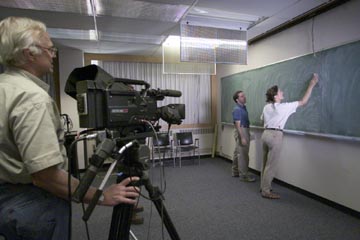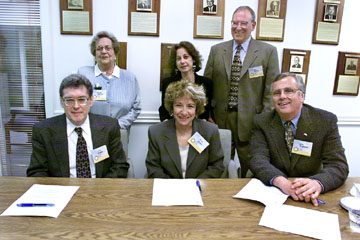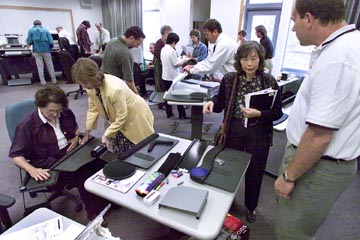
|
Lab Researchers Star on PBS |
Berkeley Lab to Co-host Carbon Sequestration Center |
- Meanwhile, on Jeopardy
- "Your New House" Air Dates
- Atoms Can't Hide from One Ångstrom Microscope
- News Digest
- In Memoriam, Wayne Pearce

- Congress Loses Key Science Champion
- New DOE Health Initiative to Benefit Workers with CBD
- Lab a Key Player in Developing Next Generation Internet
- DOE Announces NGI Funding
- Maxwell Prize Goes To Lab Mathematician
- Computing Allocation Process Open At NERSC
- Getting Down in the Mud: Lab Coat with a Heritage
- Bulletin Board (Announcements and Events)
- Calendar of Events
- August EH&S Classes
- Softball Club Standings
- Flea Market
- Flea Market Ad Policy
Lab Researchers Star on PBS
By Paul Preuss
Anyone reading the credits of PBS science specials this year might get the impression that the network turns to Berkeley Lab whenever it needs a star. Half a dozen researchers from the Life Sciences, Earth Sciences, and Environmental Energy Technologies Divisions have already appeared on PBS or soon will.
"Stealing Time"
Judith Campisi of Life Sciences held the anchor position in the hour-long special "Stealing Time: Turning Back the Clock," which aired in June. The show focused on researchers pursuing a variety of approaches to slowing the aging process -- by limiting calories, inhibiting free radicals, getting plenty of exercise, and using growth hormones, among others.
At the end of the hour, in a refreshing dose of basic science, Campisi explained with vivid clarity her research on the cellular and molecular basis of aging. At one point Campisi, a potter by avocation, sliced successive bits of clay "telomeres" off the ends of model clay "chromosomes" to illustrate the mechanism that signals cells to stop dividing.
Campisi called efforts to halt aging by preventing the shortening of telomeres, and thus prolonging cell division, "a dangerous approach" that could mimic the behavior of cancer cells. "A better approach would be to restore the function of senescent cells," Campisi said, referring to cells that live on after they have lost the capacity to divide and can contribute to tissue malfunction.
"Intimate Strangers" Goes to Chernobyl
Jennie Hunter-Cevera, head of the Center for Environmental Biotechnology (CEB), and Terry Hazen, a member of CEB and leader of the environmental remediation technology program in the Earth Sciences Division, both star in an episode of the PBS series "Intimate Strangers: Unseen Life on Earth," to air in November.
The episode titled "Creators of the Future" tracks Hunter-Cevera to the Ukraine, where she and colleagues from the Institute of Microbiology and Virology in Kiev visit an evacuated and completely abandoned city near Chernobyl where, she comments, "you can almost hear the ghosts." The group then travel to the ruins of Reactor 4 to gather soil samples.
Under the Department of Energy's Initiatives for Proliferation Prevention, Berkeley Lab is cooperating with the Kievan institute in the search for novel biological products, including enzymes produced by unknown or mutated microbes in Chernobyl's radioactive environment. Speaking of her brief excursions into hot areas where even the camera crew was barred, Hunter-Cevera admits to "a little fear and anxiety," but says its good because "it keeps you on your toes."
A different legacy of contamination was left at the Savannah River Site in South Carolina, called by the show's narrator "the most polluted tract of land in the United States," where reactors produced plutonium during the Cold War. In another segment of "Creators of the Future," Terry Hazen discusses bioremediation methods he pioneered to clean up one area of the site contaminated by chlorinated solvents.
Hazen pumped methane into the ground to encourage the growth of colonies of indigenous methanotrophs. "The same enzyme that allows the microbes to consume methane will degrade the chief contaminant here -- and 250 others as well," says Hazen. In less than two years, the test area was completely free of contamination. "The smallest of God's creatures have the potential to clean up our worst problems," he remarks.
These are two prominent examples of what Hunter-Cevera, who returns for the episode's wrap-up, calls the "Age of Biology," which may supplant the Age of Machines -- a concept strikingly illustrated by the "Intimate Strangers" series' spectacular microphotography and quirky animation.
Energy Efficiency Next on NOVA
"NOVA" and "Frontline" are teaming up to present a two-hour program early next year on energy efficiency in which Alan Meier and Jonathan Koomey of EETD will be featured players. They were photographed earlier this month by a crew that included cameraman Bob Elfstrom, the award-winning cinematographer and codirector of Berkeley Lab's own video, "The Joy of Discovery."
Meier, a ranking editor of Energy and Buildings and Home Energy magazines, leads building energy measurement and performance analysis in EETD's Energy Analysis Department. He is noted for the energy-saving features in his own home, where he greeted the PBS crew at 7:45 in the morning. "I learned that I need to keep my eye on the producer, not the camera," he says, "and to wear solid, pastel colors."
After four hours of taping as he measured electricity leakage in a neighbor's house and another few hours of on-camera discussion the crew left for Berkeley Lab to catch up with Koomey.
Koomey is the leader of the Lab's Energy End-use Forecasting Group, which serves the DOE and the Environmental Protection Agency. "We're interested in turning data on energy use into useful information," Koomey says, "for example in calculating how much energy can be saved using Energy Star appliances versus the standard kind, or driving a compact car versus an SUV" -- the kinds of decisions people make for themselves. "We want to make real to people the effects of their choices," he says.
These PBS television specials and the series on aging, new biological products, environmental clean-up, and energy conservation are bringing home the contributions of the Lab's researchers to a range of down-to-Earth issues facing American citizens.
Cameraman Bob Elfstrom films EETD's Jonathan Koomey for a joint NOVA/Frontline show on energy efficiency. Show producer Michaela Barnes is next to Koomey.Berkeley Lab to Co-host Carbon Sequestration Center
By Lynn Yarris
The U.S. Department of Energy has named Berkeley Lab as co-host of one of two new centers for global climate change research. Berkeley Lab's center will focus on carbon sequestration -- the capture and long-term storage of atmospheric carbon dioxide -- in the oceans.
"The Energy Department centers will help coordinate research across an enormous breadth of disciplines from both government and academia," said Martha Krebs, director of DOE's Office of Science. "Breakthroughs from these centers could lead to new, environmentally acceptable ways to help address this global problem."
The Center for Research on Ocean Carbon Sequestration, which Berkeley Lab will co-host with Lawrence Livermore National Laboratory, is to receive a total of $3 million over the next three years.
From Berkeley, the center will be led by Jim Bishop of the Earth Sciences Division (ESD), and from Livermore, the leader will be Ken Cal-deira. Initial collaborators will included researchers from the Massachusetts Institute of Technology, Moss Landing Marine Labs, the Pacific International Center for High Technology Research, Rutgers University, and the Scripps Institute of Oceanography.
In its official announcement of the new centers, the U.S. Department of Energy stated that the Berkeley-Livermore center will research the feasibility, effectiveness and environmental acceptability of ocean carbon sequestration.
"It may be possible to increase the amount of carbon dioxide absorbed by the ocean through direct injection of carbon dioxide into the deep ocean or through fertilization of marine organisms, such as plankton, living in the surface ocean," DOE said in a press release. "Research will assess the environmental consequences of carbon dioxide injection and ocean fertilization as well as analyze relevant environmental policies. Research will combine observations and experiments in the ocean and computer modeling of ocean currents and the diffusion of carbon dioxide."
High volumes of carbon dioxide (CO2) emissions promote global warming, and two hundred years of industrialization has resulted in the emission of an enormous amount of CO2 into the atmosphere. Experts expect atmospheric CO2 concentrations to double from pre-industrial levels by the middle of the next century.
Although scientists cannot fully predict the future impact of CO2 build-up, the scientific consensus is that serious environmental consequences are possible unless the management of CO2 emissions improves.
Earth Sciences Division Director Sally Benson is the co-chair of a national task force commissioned by the DOE to develop a research roadmap for investigating carbon sequestration. The goal is to prevent CO2 emissions from reaching the atmosphere by capturing a significant amount, as much as 4 billion tons by the year 2050, and securely storing it in the oceans or in terrestrial ecosystems.
"Science has made the case that a critical factor in global climate change is the ecosystem -- air-water interaction of anthropogenic carbon emissions," says Benson. "The idea behind carbon sequestration is to capture and isolate the carbon at the source of emission or remove it from the atmosphere."
While most scientists agree that the oceans and terrestrial ecosystems could serve as natural biological scrubbers for CO2, Benson says that there is much to be learned before carbon sequestration is put into practice. In choosing the hosts for its new carbon sequestration centers, the DOE invited the national labs to submit proposals in collaboration with other academic institutions. The department then chose the hosts using a competitive peer review process.
Berkeley and Livermore national labs will head a consortium of institutions as part of a new center to study the capture and storage of atmospheric carbon dioxide in the ocean. Another center will focus on carbon sequestration in terrestrial ecosystems. Atmospheric carbon dioxide is believed to be contributing to global warming.
Atoms Can't Hide from One Ångstrom Microscope
Record-breaking atomic resolution
By Paul Preuss
In a first for electron microscopy, the One-Ångstrom Microscope (OÅM) at the National Center for Electron Microscopy (NCEM) has resolved nitrogen atoms in the presence of more massive gallium atoms in gallium nitride, in columns spaced only 1.13 angstroms apart.
"The ability to make images of light elements such as carbon, nitrogen and oxygen in solids at atomic resolution is a very big step forward -- and it was achieved by a technique that can be a routine tool in the future," says NCEM's Christian Kisielowski, who with Michael O'Keefe and their Materials Sciences Division colleagues Christian Nelson, Chengyu Song and Roar Kilaas recently announced the record-breaking result.
Adds Kisielowski, "This is of great interest to science and industry," because many of the most promising solids under investigation today, including superhard materials, high-temperature superconductors, and semiconductors with large band-gap energies, incorporate light elements in crystal lattices at short interatomic distances.
"Seeing small atoms at atomic resolution has always been a challenge, because they don't strongly scatter the electrons in the microscope's beam," says Michael O'Keefe. "When the light atoms are close to heavy ones, it has been virtually impossible to resolve them. Heavy atoms scatter electrons much more, and as a result the interference pattern is just too complex to resolve."
Kisielowski explains that "the OÅM overcomes this difficulty by making a through-focal series of images -- in the case of the gallium nitride, 20 different images...then uses computer processing to unscramble the electron waves and combine them into a single high-resolution image. It's a way of going from the complexity of the lattice images produced by the OÅM to the simplicity of crystalline structures."
The OÅM has also produced images of columns of carbon atoms in a diamond lattice, only 0.89 angstrom apart -- that's less than one ten-billionth of a meter -- in a spectacular demonstration of a promising technique for extracting more resolving power from mid-voltage electron microscopes.
In the early 1990s the competition for higher resolution was involving ever higher voltages and ever more expensive machines, and theorists sought ways to achieve better results with more reasonable means. O'Keefe proposed a way to computer-process through-focus images to achieve higher resolution from a medium-voltage microscope, an approach first suggested in the late 1960s.
Electron beams are the basis of all transmission electron microscopy, and through-focus methods depend upon beams with all electrons at nearly the same energy. Not until the early 1990s did field-emission beam sources become stable enough for medium-voltage instruments to operate reliably.
"Such a microscope can be designed so that its `information limit' (the limit to which it produces phase-scrambled information) lies well beyond its traditionally defined nominal resolution, with all the transferred information in phase," O'Keefe explains. "By combining information from many images, a single image with resolution approaching the information limit can be achieved in practice."
When a group of researchers working in the European Commission's BRITE-EURAM program set out to build a new generation of high-resolution electron microscopes using medium voltages, they invited NCEM to be a partner in the project based on the center's high-resolution expertise and O'Keefe's theoretical contributions. In 1993, NCEM was able to secure the funds to acquire a suitable instrument, a Philips CM300.
Although a typical CM300's resolution limit is 1.7 angstroms, O'Keefe layed out specifications that would optimize the instrument's information limit. The recent results confirm the OÅM's capacity to produce phase-scrambled information far beyond 1.7 angstroms.
In the case of diamond, Kisielowski, O' Keefe and colleague Y.C. Wang showed that the OÅM's information limit extends to at least 0.89 angstrom. And as planned, powerful computer programs used to process the focal-series images have allowed OÅM to reconstruct spectacular new images with resolutions near its information limit.
Meanwhile, the ARM -- NCEM's "grandfather" microscope -- is far from being outmoded by its diminutive descendant. The OÅM can only produce ultra-high resolution with samples less than a hundred angstroms thick. The ARM can use samples that are three times thicker and composed of heavy atoms, yet still achieve a respectable resolution. A high-voltage microscope can accommodate larger sample holders, which are required to perform dynamic experiments, such as in-situ straining or heating.
While the ARM will see wide use for years to come, today the ultra high-resolution performance of OÅM is unsurpassed. The 1.13-angstrom resolution achieved with gallium nitride, allowing images of its nitrogen atoms as well as its gallium neighbors, stands as an extraordinary achievement -- but also as a challenge to Kisielowski, O'Keefe and their colleagues.
Says Kisielowski, "We're aiming to investigate materials with even shorter bond lengths with the present information limit. We want to have procedures in place that work reliably and fast to make the experiments available to our user community as soon as possible. Colleagues from other laboratories have already started to share our excitement by investigating their own samples with the OÅM."
Uli Dahmen, head of NCEM, shares Kisielowski's enthusiasm. "This achievement is based on more than six years of team effort in planning, installation and testing. After all this time, it's a thrill to actually see it work. NCEM has reached a very important milestone," he says, and adds:
"The one angstrom barrier has been a Holy Grail for electron microscopists worldwide...The OÅM makes a truly extraordinary addition to Berkeley Lab's scientific `toolbox,' and I can't wait to see what new discoveries it will bring for our users."
For more information on NCEM and the OÅM, visit the web at http://ncem.lbl.gov/ncem.html and http://ncem.lbl.gov/frames/oam.htm.

NCEM's One Ångstrom Microscope can resolve columns of nitrogen atoms (represented here by the light dots) from the gallium atoms, spaced only 1.13 angstroms apart.
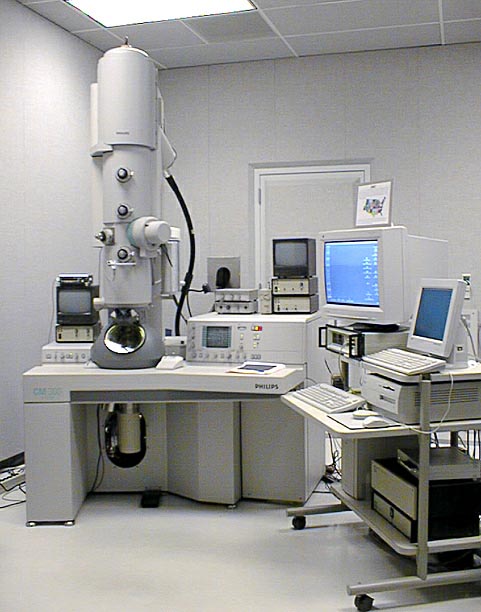
The One Ångstrom Microscope at the Lab's National Center for Electron Microscopy.
"Your New House" Air Dates
Several segments of Michael Holigan's "Your New House," a syndicated show on home buying and home improvement, were filmed at EETD last spring and will air this fall.
Cool roofing materials, the low-swirl burner, and aerogels will be featured on Oct. 6 from 7:00 to 8:00 p.m. PST on the Discovery Channel.
A segment on automated shades at the Oakland Federal Center will air on Oct. 8 from 7:00 to 8:00 p.m.
More EETD segments are in the can, including a long piece on the Lighting Lab, but have not yet been scheduled for airing.
Meanwhile, on Jeopardy
Fans of the TV quiz-show "Jeopardy" know that questions are phrased as answers and answers as questions. Last week in Baltimore, DOE's John Talbott caught an episode in which the question was "This material was identified by California Researchers as effective for household repairs -- except for sealing air ducts."
Talbott reports, "The contestant correctly responded, `What is duct tape?"'
Those "California Resear-chers" are, of course, Berkeley Lab's own Max Sherman and Ian Walker of EETD.
News Digest
Lab Scientists to Participate in Program to Study Aging
On July 15, Berkeley Lab, UC Berkeley and BioTime, Inc., a Berkeley-based biotechnology company, signed an agreement creating an endowed program for the study of the aging process. The program will honor UC Berkeley professor Paola S. Timiras, who will chair the research committee and will soon move her group to Berkeley Lab to participate in the recently-established Center for Aging Research and Education (CARE). Gathered at the signing ceremony are (left to right) Paul Segall, chairman and CEO of BioTime, Paola Timiras, Mina Bissell, director of Life Sciences, Judy Campisi, director of CARE, Ronald S. Barkin, president of BioTime, and Don McQuade, Vice Chancellor of University Relations. Photo by Roy KaltschmidtIn Memoriam
Wayne Pearce
Wayne T. Pearce, a retired scientist who worked in the Environment, Health and Safety Division for more than three decades before retiring in 1996, died on June 20 at the Bayview Nursing and Rehab Center in Alameda following a short illness. He was 65.
An environmental researcher, Pearce's specialty was air sampling, according to Richard Harvey, a retiree who used to work closely with him. "He was one of the hardest workers I ever knew," Harvey said of his friend and colleague. "Wayne was the epitome of Anglo-Saxon work ethic. He was very serious, all business. He had many hobbies, including photography, playing the piano, even attending City Council meetings, but he was business-like about his hobbies as well."
Pearce was born in Massachusetts and attended Columbia University. A veteran of the US Air Force, he served at Iwo Jima in 1952. Throughout his life he was active in community, political and civic affairs. His interest in environmental issues extended beyond his profession, to involvement in various ecological causes.
He is survived by his mother Millie Gray Blessing Priest and sister Lynne Priest Fitzpatrick, both of Greenbelt, Maryland. Services were held in Massachusetts.
Congress Loses Key Science Champion
George Brown: 1920 - 1999
By Monica Friedlander
Congress lost "an irreplaceable voice for science and justice," President Clinton said of Rep. George Brown, dean of the California congressional delegation, who died on July 15 of an infection contracted after heart valve replacement surgery in May. He was 79.
An 18-term Democratic congressman and the oldest member of the House of Representatives, Brown was first elected to Congress in 1962 during John F. Kennedy's presidency. He served until 1970, gave up his seat for an unsuccessful run for the U.S. Senate, and was reelected to the House just two years later.
Brown gained national attention for his early and fierce opposition to the Vietnam War, but was remembered by his Republican and Democratic colleagues as a nonpartisan friend of science, civil rights, the environment, and space exploration.
"With George, a commitment to science always rose above party labels," said Rep. F. James Sensenbrenner Jr. (R-Wis), chairman of the House Science Committee. "America has lost its foremost science advocate."
For Brown, science and technology were more than legislative issues -- they were his passion. He pushed for development of solar power, supported space travel, and championed the creation of the Environmental Protection agency. In 1995 he lobbied to boost the 1996 budget for renewable energy and energy efficiency programs.
Also a passionate environmentalist, Brown introduced the Sequoia Protection Act this year to eliminate commercial logging and mining in areas of Sequoia National Forest. This was the last piece of legislation he sponsored.
With a cumulative 34 years in the House of Representatives, Brown was the longest serving congressman in California history.
Earlier this year Brown told the New York Times, "From my earliest days, I was fascinated by science. I was fascinated by a utopian vision of what the world could be like. I've thought that science could be the basis for a better world, and that's what I've been trying to do all these years."
New DOE Health Initiative to Benefit Workers with CBD
Current and former DOE contract workers who suffer from a disease caused by their exposure to beryllium at DOE nuclear facilities would become eligible for financial assistance under a new Clinton administration proposal. The legislation would reverse DOE's long-standing practice of opposing most worker health claims.
"This is long deserved and long overdue," said Secretary Richardson in announcing the initiative. "Many of the men and women who helped us win the Cold War worked in extremely hazardous conditions and were exposed to extremely hazardous substances. Those who contracted Chronic Beryllium Disease (CBD) deserve to receive the same occupational illness benefits available to regular federal employees."
CBD is a debilitating lung disease caused by exposure to beryllium -- a metal used by the government in the production of nuclear weapons, which has been used at 20 DOE sites. While symptoms of the disease can be arrested with treatment, no cure exists.
The new program will be modeled after the Federal Employees' Compensation Act program and will be administered by the Department of Labor. All DOE contract workers, including those employed by the companies who supplied the government with beryllium products, will be covered.
Benefits to be paid under the program are estimated at about $13 million per year over the next 10 years. Almost 20,000 workers may have been exposed to beryllium at DOE sites. To date, DOE screening programs have identified 115 cases of the disease among current and former workers. Workers covered by the legislation are eligible to receive reimbursement for medical costs and compensation for lost wages, permanent impairment and vocational rehabilitation assistance.
More information is available online at http://www.eh.doe.gov/benefits and http://www.eh.doe.gov/be . A toll free number (1-877-447-9756) has also been set up. --Monica Friedlander
Berkeley Lab Currents
Published twice a month by the Public Information Department for the employees and retirees of Ernest Orlando Lawrence Berkeley National Laboratory. Ron Kolb, PID department head.
EDITOR: Monica Friedlander, (510) 495-2248, msfriedlander@lbl.gov
STAFF WRITERS: Paul Preuss, 486-6249; Lynn Yarris, 486-5375
CONTRIBUTING WRITERS: Jon Bashor, X5849; Allan Chen, X4210, Jeffery Kahn, X4019
FLEA MARKET / CALENDAR: Jacqueline Noble, 486-5771
fleamarket@lbl.gov / currents_calendar@lbl.govPublic Information Department, Berkeley Lab, MS 65A
One Cyclotron Road, Berkeley CA 94720
Tel: 510/486-5771 Fax: 510/486-6641
Berkeley Lab is managed by the University of California for the U.S. Department of Energy.
Lab a Key Player in Developing Next Generation Internet
By Jon Bashor
Berkeley Lab will be a key player in Department of Energy programs aimed at making the Internet an even more useful tool for scientific experimentation and collaboration than it is today.
Last month, the Department of Energy's Office of Advanced Scientific Computing Research announced funding for 19 research proposals, of which the Lab's Computing Sciences Directorate is a partner in eight, with nearly $3 million in additional funding for FY99 alone. The research program is part of the Next Generation Internet (NGI) -- a multi-agency federal R&D program to develop, test and demonstrate advanced networking technologies and applications.
NGI's goal is to take advantage of greater bandwidth to allow researchers to quickly and easily access and exchange very large sets of data. It is currently difficult to provide uniform access to data at various sites and to allow researchers at different locations to combine and use that data. NGI is aimed at providing the tools and technologies to achieve that through the use of advanced networking technologies.
"What we're trying to do is prototype the computing and networking environment in which scientists will be working in three to five years," said Bob Lucas, head of NERSC's High Performance Computing Research Department. "Our role in nearly half of all the DOE-funded programs continues Berkeley Lab's tradition of leadership in networking, which goes back to the early 1980s."
The initiative's first major thrust involves remote visualization of large amounts of scientific data by researchers at different institutions. The nationwide scientific community has only a few research centers with supercomputers and large data-storage tape archives, and far fewer scientific visualization centers. The goal is to make these centers remotely accessible and easily usable by scientists collaborating on projects nationwide.
"For example, we'd like to make it routine for researchers at Sandia National Laboratories and the University of Wisconsin to view data generated at Berkeley Lab," Lucas said.
Berkeley Lab is a partner in three such visualization programs and the lead lab in two of them: developing a prototype environment for remote, collaborative visualization of large combustion simulation data sets; and developing visualization-sensitive network protocols.
Current models for combustion are not capable of handling the huge amounts of data expected to be generated by the next generation of supercomputers. This capability is important to help researchers understand the mechanisms of combustion and to apply this knowledge to solving engineering problems such as building cleaner, more efficient diesel engines.
Another NGI theme is developing a network infrastructure to share and access data around the world. Lucas, quoting collaborator Richard Mount of SLAC, describes this thrust as "competing with UPS to quickly and efficiently ship bulky data around the country."
Said Lucas, "We will be developing the infrastructure giving users transparent access to data, no matter where its stored. They'll also be able to move it rapidly back and forth, say between SLAC at Stanford and Argonne National Laboratory in Illinois."
Lucas also added that the Lab's achievements in high-performance computing and networking contributed to the success of its proposals, but even more convincing was the coordination with colleagues at Argonne and Los Alamos national laboratories. Other collaborating organizations include Lawrence Livermore and Sandia national labs, the National Center for Atmospheric Research, Princeton University, and the Universities of Illinois, Utah, Wisconsin, and Southern California.
"We coordinated our proposals in such a way that DOE received a sum greater than the whole of the parts," Lucas said. "Each component will make the others more effective and useful. We gave them both excellent technical vision and solid partnerships."
DOE Announces NGI Funding
The Department of Energy announced this week that it is awar-ding $15 million to researchers at 17 universities and nine DOE laboratories for research on the Next Generation Internet.
Nineteen projects will be funded over three years. In addition to Berkeley Lab, participating labs are Argonne, Brookhaven, Fermilab, Los Alamos, Livermore, Sandia, SLAC, and the Thomas Jefferson National Accelerator Facility.
Twelve projects are basic technology projects to develop the underlying network architecture and monitoring technologies needed to support scientific Internet traffic. Five will integrate and test the technologies on DOE-related research and two are university testbeds to link the new tools to researchers at universities.
Maxwell Prize Goes To Lab Mathematician
Grigory Barenblatt, one of Russia's most distinguished applied mathematicians who now holds a joint appointment in Berkeley Lab's Computing Sciences Division and the math department at UC Berkeley, has been awarded the Maxwell Prize, a new international honor in applied mathematics.
Barenblatt is an expert in the analysis of problems dominated by complexity. He, along with colleague Alexandre Chorin, made headlines a year ago with the discovery of a flaw in the "Law-of-the-Wall," an aerodynamic equation that had been a standard for 60 years. His work on the formation of cracks in solids was the basis of many of the tools used today in the analysis of failure due to fatigue.
"The range of Barenblatt's achievements is truly breathtaking," said the International Congress on Industrial and Applied Mathematics in awarding him the prize.
Barenblatt is a foreign associate of both the National Academy of Sciences and the National Academy of Engineering, and a foreign honorary member of the American Academy of Arts and Sciences.
Established this year, the Maxwell prize was named for the great 19th century Scottish physicist James Clerk Maxwell; it provides international recognition to a mathematician who has demonstrated originality in applied mathematics.
Computing Allocation Process Open At NERSC
The National Energy Research Scientific Computing Center (NERSC), which provides high-performance computing and data storage resources to Department of Energy researchers, is now accepting applications for allocating resources for FY2000.
Applications for the coming fiscal year will be accepted through Wednesday, Aug. 4. Award letters will be sent out on Sept. 20, and awarded allocations will take effect Oct. 1.
The allocation process, called ERCAP (Energy Research Computing Allocation Process), is entirely web-based, and applications must be submitted using a web-based form. For more information visit the website at http://ercap.nersc.gov.
Earlier this year DOE announced a new policy of broader scientific peer review for the use of NERSC, the Department's largest unclassified scientific computing facility. As proposals are submitted, they will be subjected to peer review to evaluate the quality of science, how well the proposed research is aligned with the mission of DOE's Office of Science, and the readiness of the specific application and applicant to fully utilize the computing resources being requested.
NERSC, which marks its 25th anniversary this year, recently announced that it has selected an IBM RS/6000 SP system as the center's next-generation supercomputer. The final system will have 2,048 processors and a peak speed of 3 teraflops (three trillion calculations per second). Installation of the first phase of the IBM system began in early summer.
NERSC also operates a 677-processor Cray T3E-900 supercomputer. Additionally, for FY2000, NERSC expects to allocate time on 64 SGI/Cray SV1 processors and 32 SGI/Cray J90se processors. The center also provides archival data storage in its High Performance Storage System, with a total capacity of 300 terabytes. For more information about the NERSC High Performance Computing Facility, visit the website at http://hpcf. nersc.gov. -- Jon Bashor
Getting Down in the Mud: Lab Coat with a Heritage
By Blake Likins
Jennie Hunter-Cevera was working for the Bristol-Myers Squibb pharmaceutical company when she received an ultimatum from her boss: find a new antibiotic in three months, or you're gone. Fortunately, Hunter-Cevera, now the director of the Lab's Center for Environmental Biotechnology, had faith in her unique ecological approach to searching for microorganisms. Her method was based on the premise that there is a connection between an organism's physiology and its environment.
"I just had to think like a microbe and get in the mud," she says.
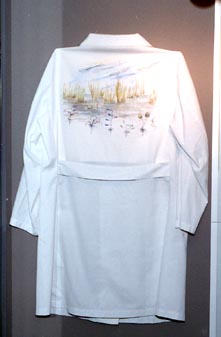
She made the discovery in Wading River, New Jersey. Later, upon receiving her Ph.D. from Rutgers University, her mentor gave Hunter-Cevera a lab coat decorated with a painting of the salt marsh where she did her fieldwork and where she found some of the microorganisms.
Hunter-Cevera developed the thread by which she could screen for compounds under the conditions in which they are naturally found. Her theories were both successful and fruitful.
"I think most great discoveries often are serendipitous and simplistic. You only find what you look for, and sometimes it's in your backyard."
The lab coat is currently being featured in a large exhibition called "A State of Health: New Jersey's Medical Heritage" at Rutgers University.
Hunter-Cevera discovered a bacterium in a New Jersey salt marsh that produced a major new class of antibiotics in 1978.
"The lab coat is a vivid reminder that the discovery of antibiotics has been done by real people who are willing to literally dig in the dirt," says curator of the exhibition Karen Reeds. "It's also a reminder that the natural world still is a vital source of new therapies -- yet another reason for environmental conservation."
Jennie Hunter-Cevera calls herself a lover and student of nature, and she continues to search for new antibiotics in nature while here at the Lab. "When you're conserving plants and animals, you are also conserving the microorganisms, even though you can't see them," she says.
Now dressed in a plain white lab coat, Hunter Cevera adds, "the message the coat sends is that if you want something, make it happen."
After her 1978 discovery, Hunter-Cevera went on to make numerous discoveries and publish many of her findings. Currently she is developing new products and processes to benefit human health and environment at the Lab.
Blake Likins is a summer intern from U.C. Berkeley who works in the Lab's Public Information Department.
Bulletin Board (Announcements and Events)
Ergonomics Takes Front Seat at Annual Fair
Everything from ergonomically-correct computer workstations, state-of-the-art adjustable chairs, and the latest accessories, such as keyboards, pointing devices, keyboard trays, and glare screens, were on display earlier this week in Perseverance Hall during Berkeley Lab's annual Ergonomic Fair. A few lucky employees even got a free massage to boot. For more information, contact Larry McLouth at X5286. Photo by Roy KaltschmidtCafeteria Prices To Go Up
Starting Monday, Aug. 2, the cafeteria will raise its prices due to higher labor costs passed on to the cafeteria operators. Questions may be directed to Bob Berninzoni at X5576.
Discount Tickets for Amusement Parks
Lab employees may purchase discount tickets for Disneyland, Magic Mountain, Sea World in San Diego, Six Flags Marine World and Six Flags Magic Mountain. Contact Lisa Cordova at X5521 or lacordova@lbl.gov for information and include your mail stop in your message.
New Weight Watchers Series
A new session of Weight Watchers has started last week. Sessions are held every Tuesday from noon to 1:00 p.m. in Bldg. 26, Room 109. For more information contact Judy Kody at X4483.
Cafeteria Reservations Go Online
Starting Aug. 30, groups will be able to reserve space at the cafeteria by using the Facilities Department's conference room website at http://ox.ee.lbl.gov/conf_rooms/. Listings for the downstairs dining room, Perseverance Hall, the main dining hall, and cafeteria lobby will include photographs and information on room capacity and services available. Cafeteria space may be reserved for lunches, meetings, exhibits and other functions. The lobby and its large bulletin board are available for displays having to do with Berkeley Lab's scientific programs and related activities.
The conference room website allows users to select a suitable meeting place from a number of locations around the Lab and make a firm reservation. For meetings scheduled in the cafeteria, the site will prevent duplicate reservations and conflicting uses. The cafeteria is available Monday through Friday during normal working hours and evenings.
For more information on cafeteria reservations, contact the Work Request Center at X6274 or wrc@lbl.gov.
Lend a Hand to the Craft Fair
Anyone interested in joining the planning group for Berkeley Lab's annual Holiday Craft Fair, to be held Nov. 18, are invited to the next meeting on Tuesday, Aug. 3, from noon to 1:00 p.m. in Bldg. 2-100B.
The fair is a big undertaking and the committee needs the assistance of volunteers to see the project through. To help out or for any questions, contact Shelley Worsham at X6123, saworsham@lbl.gov.
To sell craft work at the fair contact Janice Rivera at LRivera@lbl.gov.
Construction Update: Bldg. 88
Parts of the parking lot by Bldg. 88 are being blocked off due to a construction project to install seismic bracing for the concrete shielding blocks in Cave Four.
The Facilities Department estimates the job will be finished by the end of September. For further information contact Charlie Allen at X6438 or project manager Lonny Simonian at X6088.
Contact Person for Tour of the Treasury Of St. Francis of Assisi Exhibit
The last issue of Currents announced a docent tour of the Treasury of St. Francis of Assisi exhibit at the California Palace of the Legion of Honor, organized by the Employees' Art Council. To purchase tickets for this event or for additional information you may contact Mary Clary at X4940, mmclary@lbl.gov.
The tour will be held on Saturday, Aug. 28, beginning at 9:00 a.m.
Additional information on the exhibit can be found at http://www.thinker.org/legion/exhibitions/assisi/index.html .
Call for Lost and Found Items
Have you lost your sunglasses, ID badge, even cash? Many such items are forwarded to the Lab's security office. If you're missing something or have found a lost item, do yourself or someone else a favor and call the office at X4855.
Courier Services
The Facilities Department is providing the Lab with rush courier service, with pick-up and delivery both on- and off-site. Transportation can deliver up to 2,000 pounds anywhere in the Bay Area or in central or northern California. Onsite materials will be delivered within one hour. For offsite service, a driver is available during normal business hours for same-day pick up and delivery. To request a pick-up, call Peggy Patterson at X5404.
Courier service (two-hour, four-hour, same day, and rush service) is also available from IDS Courier, which operates 24 hours a day and provides pick-up and delivery anywhere in the Bay Area and in portions of northern and central California. For information call Linda Wright at 548-3263.
Calendar of Events
The Berkeley Lab Calendar is published biweekly here on the World Wide Web and in Currents by the Public Information Department. Employees can list a meeting, class, or event in the Calendar by using this submission form. The deadline for submissions is 5 p.m. on Monday in the week that Currents is published.
In addition to the events listed below, Berkeley Lab's Washington, D.C. Projects office is hosting a Science and Technology Seminars series.
Scientific Conferences
General Interest
TUES., AUGUST 3
CRAFT FAIR PLANNING MEETING
Noon, Bldg. 2-100B
WED., AUGUST 4
MEET THE APPLE COMPUTER TECHNICAL SERVICE REPRESENTATIVES
11 a.m., Bldg. 90-3148
SUMMER LECTURE SERIES
Drilling Through a Volcano,
Noon, Bldg. 50 auditorium
THURS., AUGUST 5
SHOEMOBILE
7:30 - 3:30, cafeteria parking lot
TRIPMOBILE
11:30 - 12:40, cafeteria parking lotTUES., AUGUST 10
NEW EMPLOYEE ORIENTATION
Starts at 9:00, Bldg. 50 auditoriumWED., AUGUST 11
MUSIC CLUB
1 p.m., lower cafeteria
Items for the calendars may be sent via e-mail to currents_ calendar@ lbl.gov, faxed to X6641 or mailed to Bldg. 65B. The deadline for the Aug. 13 issue is 5 p.m. Monday, Aug. 9.
Seminars & Lectures
AUGUST 6, FRIDAY
Department of Geological and Environmental Sciences
"Numerical Modeling of Coupled Surface-Subsurface Water Flow and Solute Transport" will be presented by Joel VanderKwaak of Stanford University.
11 a.m., Bldg. 90-2063AUGUST 12, THURSDAY
Surface Science and Catalysis Science
"Ultrafast Charge Transfer at Surfaces" will be presented by Dietrich Menzel of the Technical University of Munich, Germany.
1:30 p.m., Bldg. 66 auditoriumAUGUST 13, FRIDAY
Earth Sciences Division
"Investigation of Preferential Flow in Faults and Fractures in the ESF" will be presented by Rohit Salve of Earth Sciences.
11 a.m., Bldg. 90-2063
Final Summer Lecture
Wednesday, August 4
Drilling Through a Volcano
Berkeley Lab's Summer Lecture Series concludes on Aug. 4 with a talk by Don DePaolo of Earth Sciences about "Drilling Through a Volcano to Uncover Secrets of Deep Earth."
Head of the Lab's Center for Isotope Geochemistry, DePaolo is one of the leaders of the Hawaii Scientific Drilling Project in Hilo. His team will drill through a large volcano to sample lava flows dating back 600,000 years at a depth of about 6,000 meters -- slightly more than the depth of the ocean -- into the 80-million-year sea floor underneath.
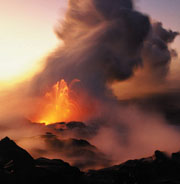
Also a professor of geochemistry at UCLA and UC Berkeley, DePaolo has been a senior scientist at Berkeley Lab since 1988.
The Summer Lecture Series is co-sponsored by the Public Information Department and the Center for Science and Engineering Education.
August EH&S Classes
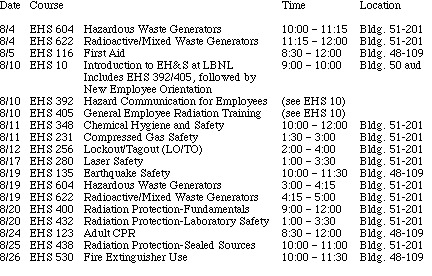
To enroll contact Susan Aberg at Saberg@lbl.gov or register via the web: http://www-ehs.lbl.gov/ehstraining/registration/. Preregistration is required for all courses except EHS 10 (Introduction to EH&S). Times and locations are subject to change. Check the EH&S training website for updates to this schedule.
Softball Club Standings
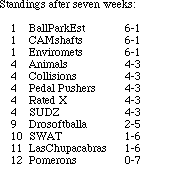
Flea Market
Autos / Supplies
`86 AUDI 4000, 4 dr, auto, 127K mi, pwr steer/wndw/lock/sunrf, ac, am/fm/cass, cruise, int good, new tires/battery/brakes, runs great, avail 8/11, $1,700, Han, X4579, 665-3745 (after 7 pm)`87 HONDA Civic Wagovan, runs great, 144K mi., manual 5-speed, am/fm/cass, blue, $2,300, Erik, X6435
`88 TOYOTA Camry wagon, auto, blue, exc cond, 196K mi, ac, am/fm/cass, clean in/out, pwr steer, new batt/brakes, runs great, avail 8/16, $3,000/neg, Tei, X2301, 495-2301
`90 TOYOTA Corolla, 4 dr, 5-spd, 115K mi, new radiator and starter, runs great, $3,900, Javier, X5446, 526-203
`91 MAZDA 626DX, 4 dr, blk, at, ac, am/fm cass, good cond, $3,850, Tennessee, 865-2553
`91 TOYOTA Corolla, auto, 4 dr, red, 96K mi, ac, am/fm/cass, pwr steer, new batt/brakes, runs great, avail 8/16, $4,000/neg, Tei, X2301, 495-2301
`95 DODGE Neon, 4 dr sport sedan, white, 66K mi, auto, ac, ABS, dual airbags, am/fm/cass, pwr steer/lock, very clean in/out, avail 8/25, $7,000/b.o., Thierry, X7498, 763 4469
BIKE RACK, trunk-mounted, carries 2 bikes, almost new (bought for $120), must sell, $60, Jamal, X5652, jjmarian@lbl.gov
TENT TRAILER, `79 APACHE-17, sleeps 6, ice box, stove, sink, current reg, $750/b.o., Kevin, X4319, (925) 833-1668
Housing
BERKELEY HILLS, modern studio apt in architect designed home on edge of Tilden Park, very quiet/private, own deck/entrance, free parking, dishwasher, full-sized fridge, lg bthrm, Murphy bed, security sys, close to LBL, bus #65, 1 person only, no smokers/pets, $900 + elec, avail 9/1, Evan, 486-6784BERKELEY HILLS, beautiful 1 bdrm/1 bth apt, remodeled, fully furnished, marble bthrm, private patio, near bus/shopping, 1 yr lease, $1,195/mo + util, avail 8/1, non-smoker, Helga, 524-8308
BERKELEY HILLS, charming 3 bdrm/2 bth fully furn house on Grizzly Peak w/ view of SF, $2,700/mo, Mary, 527-4450
BERKELEY, sm private studio, Grizzly Peak, nice view, 10 min to LBL, bus 65 directly to campus, sep entrance, detached, $550/mo + util, furn if requested, avail in mid Aug (possibly earlier), Pinky, 559-4681, psli@lbl.gov
ELMWOOD, share elegant 11 rm house w/ 2 men, 1 woman, non-smoking professionals, mstr bdrm w/ frplc and huge closet, some weeknight omnivorous dinners, piano, yellow Labrador, laundry, sauna, hardwd floors, exc neighborhood, $745/mo + deposit, shared exp, woman pref, Tony, 841-4480
Miscellaneous
49er TICKETS, section 6/lower reserved, row 2-seats 18 & 19, $75 ea, cash only, Sheryl, X5126AIRLINE TICKETS (2), anywhere Delta Airlines flies in the continental US, travel must be completed by 9/14/99, b.o, Doris, X5568
BABY BUGGY, Chicco Fly (European model), very nice, good cond, weatherproof sun roof, very convenient to store in sm cars, $50, Jens, X6174, 524-7216
BIKE, Specialized Sequoia road/city, 21 gears, exc cond, good parts, incl U-lock/lights, $195/b.o., Torben, X6884, 540-6880
BUNK BED modules, red tubular metal, child's, converts from single to bunk bed arrangement, $25; commercial drafting table w/ drafting machine, $100; birch 9-drawer drawing case for "E" size or larger drawings, $75; John, (415) 388-6230
FUTON w/ frame, double, $40; platform bed, full, natural wood, $100; large "popasan" chair, $40; 42" dia dinette w/ 4 chairs, $50; 30"x30" to 50" teak dining table, $40, Worley, 527-3869
HUTCH, Drexel Heritage China, lighted, exc cond, $375, Kathy, X4903, (925) 685-5659
MAC OS 8.5, CD in orig box w/ document, never installed, $45/b.o. (retail $90+), Ed, 339-3505
MOVING SALE, 19" TV (RCA), $100; VCR (Philips), $70; microwave, $40; dining table+4 chairs, $70; futon/couch, $50; TV stand, $25; bookcases (2), $15 ea; desk, $10; coffee table, $7; toddler bed, $25; mattress w/ box (twin & full), $30 ea; vacuum cleaner, $30; 3-rm Greatland tent (used once), $100; iron $6; bed-side halogen lamp, $12; digital answering machine, $17; telephone (AT&T), $8; kitchenware, more, Thierry, X7498, 763-4469
MOVING SALE, all prices 50 % or less of purchase price, every 110 V item has to go, steam iron + table, $10; Trek bike helmet (white, large), $15; 2 solid pine book cases, 10" deep (3'x3' + 2 shelves, 2'x2' + 1 shelf), $80; 30 black wired 15"x15" metal pieces + connectors, build modular storage cubicles/rows/ columns/etc, $60; solid wooden table, 50"Wx14"Hx24", $20, table (6'Wx28"Hx30") $15; coffee maker, $5; Braun hand blender + whip disk, $5; cork board, $3; green plant (60"H) + pot + wooden parrot (life size), $15; Erik, X4555, 528-0484 (after 6 pm)
SPEAKERS, ESS AMT 1A stereo, towers, clean sound, exc cond, $400/ pair, Kathy, X4903, (925) 685-5659
TIRES, Michelin Energy MXV4, 195/65HR15, top-rated all season, 140 mi (changed wheels), (4) at $70/ea ($125 retail), Brent, X5614 or Krista, X7523
Wanted
HOUSING, 1 rm, year-round, prefer next to campus on south side and under $500, Jenny, X7654, 666-8944HOUSING for LBNL postdoc (family of 2), arrive in Sept, 1 bdrm apt, furn or not, Berkeley, El Cerrito or Albany, Altaf, sarker@med.okayama-u.ac.jp
HOUSING, small house or 2 bdrm apt for visiting scientist, spouse and 2 kids, house-sitting possible, Jens, X6174
HOUSING, room or apt for visiting female postdoc, 8/27-10/4, clean and quiet, can share, house or dog sit, s_cenci@usa.net or Alex, X5050
TICKETS, last SF Giants vs. LA game at 3Com Park, Sept. 30, will pay cash or trade for other Giants games, Christopher, X6629
Vacation
SO LAKE TAHOE, spacious chalet in Tyrol area, close to Heavenly, peek of Lake from front porch, fully furn, sleeps 8+, sunny deck, close to casinos, shopping, more, $155/day, Maria, 724-9450Vanpool
PETALUMA/NAVOTO/BERKELEY, 8 am - 5 pm, Hannah, X6188 or Terry, (707) 763-1877Free
RC airplane engines, parts, etc, Dave, X4171ROCKS, 3/4", white quarts, about 4 cu yd, you haul, Dan, 799-0818
Lost & Found
LOST: Mitt, after the 6 pm game on 7/21, has name "Randy" and team name "Animals" on it, Randy X6354
Note: For other lost and found items call X4855.
Flea Market Ad Policy
Ads are accepted only from LBNL employees, retirees, and on-site DOE personnel. Only items of your own personal property may be offered for sale.Submissions must include name, affiliation, extension, and home telephone number.
Ads must be submitted in writing--via e-mail (fleamarket@lbl.gov), fax (X6641), or delivered/ mailed to Bldg. 65B. No ads will be taken over the phone.
Ads will run one week only unless resubmitted in writing. They will be repeated only as space permits.
The deadline for the Aug. 13 issue is Friday, Aug. 6.
